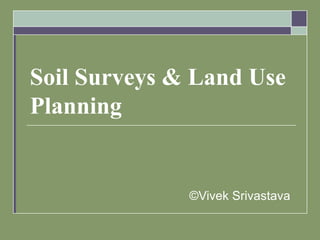
Soil survey and land use
- 1. Soil Surveys & Land Use Planning ©Vivek Srivastava
- 2. Objectives Knowledge of purposes & uses for soil surveys Identify tasks for soil survey & the reports involved Methods of soil evaluation & interpretation Use of electronic databases
- 3. Introduction Soil survey – fact-finding mission, following by a report on the findings Description of the characteristics of the soils in a given area Classification of the soils Delineate boundaries of soils on a map Predictions of behaviors of the soils
- 4. Introduction Contain Data for many users Farmers, forecasters agronomists: evaluate potential production of the soil, management needs to maximize that potential Planners, community officials, engineers, developers, home buyers: evaluate the site for building construction purposes, strengths, limitations
- 5. Conducting a Soil Survey Before any surveying begins, a plan is made & information is collected Conferences Collect aerial photographs Satellite images Initial field reviews
- 6. Soil Survey Reports Contents of a Soil Survey
- 7. Conducting a Soil Survey Preparation of a legend Initial field reviews conducted in soil pits in the most extensive landforms Soil-mapping unit: area of soil that is delineated from adjacent areas on a map Differences may be: Slope Erosion Soil profile
- 8. Soil Survey Reports Physical & chemical properties of the soils Soil & water features Chemical analysis Clay mineralogy Engineering index data Soil classification
- 9. Soil Survey Reports Natural fertility Soil depth Tendency to accumulate soluble salts Soil structure Soil engineering properties Climate Natural vegetation Adapted crops & their expected productivity
- 10. Soil Survey Reports Recreational development potential Wildlife habitat Building site development Sanitary facility needs Construction materials Water management Engineering index
- 11. Soil Survey Reports Value of Detailed Soil Survey Reports Most soil properties recorded in a soil survey change very slowly Typically semiperminent properties: Land relief (topography) Soil texture Organic matter content Geologic origin
- 12. Soil Survey Reports Reasons why a resurvey may be done: Some information was not gathered in a previous survey New management practices Changes in crops grown Yield prediction changes http://soils.usda.gov
- 13. Land Evaluation Land-use planning done for: urban areas, rural areas Major issues: Quality of environment Environmental sustainability of ag production systems Pollution of nitrate, phosphate, pesticides Erosion of land Declining soil fertility
- 14. Land Evaluation Problems caused by these issues may have various/multiple facets Agronomic Economic Political Social
- 15. Land Evaluation LESA system – Land Evaluation and Site Assessment Guide the conversion of farmland to urban uses Attempts to preserve the best farmland Three procedures: Land capability classification Current category of land is documented Soil rated according to capability
- 16. Land Evaluation Land Capability Classification Classification & sub classification for all soil- mapping units Class I Soils Can be used continuously for intensive crop production w/ good farming practices No restrictions Class II Soils More limitations than Class I land for crop production 2-5% slope is main difference
- 17. Land Evaluation Class III Soils Severe limitations Requires more special conservation practices than Class II to keep it continually productive Can have shallow soil Slopes 6-10% Shallow water tables
- 18. Land Evaluation Class IV Severe limitations for cropping use Greater intensity of conservation practices for cultivated crops that Class III Recommend permanent crops (e.g. pastures) Slope 12-18% Class V Boulders, wetness, problems impractical to correct Not necessarily erosion risk Can’t be cultivated Use for pasture, range, woodland, wildlife habitat
- 19. Land Evaluation Class VI Slope 18-30% Same limitations as Class V soils, except more need for sustainable management practices Class VII Severe limitations Extreme care to protect the soil Even using grazing, wildlife, timber Slope >30%
- 20. Land Evaluation Class VIII Very severe limitations Steep slopes, rock lands, swamps, etc. Can only be used for wildlife, recreation, watersheds, aesthetic appreciation Land capability subclasses – soil groups w/in the 8 classes that explain the reasons for limitations of intensive crop production e – erosion hazard w - wetness
- 21. Land Evaluation s – shallow, droughty, stony, permafrost c – climate too cold or dry
- 23. Land Evaluation Ratings for Soil Potential Indicates the relative quality of a soil for a particular use compared with other soils in a given area Developed for planning purposes Supplement land capability classes, woodland suitability groups, range sites, soil limitation ratings
- 24. Data Interpretation for Soil Uses Can be rated to have slight, moderate, severe limitations Severe Soil will require major soil reclamation, special design, high costs, or intensive soil maintenance to use for the item listed Very Severe Great difficulty in the soil’s use, high costs, or both
- 25. Data Interpretation for Soil Uses Slight & Moderate May indicate problems w/: Shallow Low permeability Strong acidity High salt concentration Various other problems
